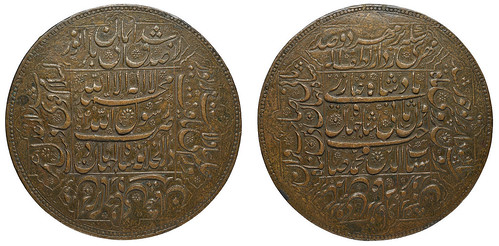
PREV ARTICLE
NEXT ARTICLE
FULL ISSUE
PREV FULL ISSUE
MORE ON THE MUGHAL MULTIPLE-MOHUR COINSPaul Bosco submitted these thoughts on the Mughal multiple-mohur coins and the copies being offered by Dix Noonan Webb. Thanks! -Editor  Ignoring the toy coinages of recent years (like the one stolen in Germany... The 100-mohur or 200-mohur coin, of which an old copy is now up for auction, was the cover coin for one or more editions of the Friedberg catalog of world gold coins. It was noted as a copy in the British Museum of the world's largest gold coin, and it was stated that the actual coin was unknown. I thought it was an electrotype, not a cast (per DNW'S description). I generally read The E-Sylum late Sunday nights, when it is not convenient to do much research. I may be remembering wrong. I also remember the denomination as being 100-mohurs. I don't know that the coin bears a stated denomination, so the weight, not the diameter, would settle the matter.? In 1987 two coins from the same series were offered by the newly formed auction house Habsburg-Feldman. I was invited by Krause publications to attend a showing, where one could examine the coins minutely in their custom frames, while eating small pieces of fabulous food. Gotta love Krause. There was a 1000-mohur and, if I remember rightly, a 500. The 1000 was something like 8-inches. I considered them the two greatest coins in the world. They were described as previously unknown. They did not sell in the auction, which consisted of only the two coins. They may have changed hands later. I think the two coins were the ONLY coins Habsburg-Feldman considered worthy enough for them to sell. Feldman was a leading stamp dealer in Switzerland; Habsburg was a bona-fide Habsburg and I think he had been an expert at Sotheby's. The claim that the piece in DNW is a copy of the world's largest coin is wrong. The (contradictory) representation that 500- and 1000-mohurs were were struck is correct, but the claim that "very few are known" is an understatement; one of each is known. Interesting! Does anyone know where those coins are today? Here's an excerpt from a 1998 PCGS article by Ed Reiter that Paul found. -Editor I got a close-up look at a truly incredible coin: a 17th-century gold piece that's roughly 8 inches in diameter and weighs nearly 32 troy pounds - including more than 29 pounds of pure gold. By anybody's yardstick, that's quite a coin! Indeed, it's said to be the largest gold coin ever made. This minting marvel, a 1,000-mohur coin, was struck in 1613 in Hindustan (present-day northern India) at the direction of a wealthy potentate named Shah Jahangir, possibly as a diplomatic gift. What happened after that remains a mystery. All we really know is that about 11 years ago, the coin - and a smaller companion piece weighing a "mere" three pounds - turned up in the possession of a European auction house which planned to put these treasures under the gavel. The company, Habsburg, Feldman S.A. of Geneva, Switzerland, calculated that the large piece would fetch about $10 million and the "small" one maybe $4 million, give or take a few hundred thousand dollars. To read the complete article, see:
To read the earlier E-Sylum article, see:
 Wayne Homren, Editor The Numismatic Bibliomania Society is a non-profit organization promoting numismatic literature. See our web site at coinbooks.org. To submit items for publication in The E-Sylum, write to the Editor at this address: whomren@gmail.com To subscribe go to: https://my.binhost.com/lists/listinfo/esylum All Rights Reserved. NBS Home Page Contact the NBS webmaster 
|